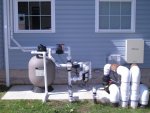Looking back at the motor pictures, I'm not sure why exactly, but I get the feeling that the motor was a reconditioned/rebuilt motor. I don't think that it was a new motor. The motor shaft is too rusty at the front and back to be a new motor. Even if water got into the motor, there would not be that much rust that fast. The shaft is high quality stainless steel and there is no corresponding corrosion in the back end of the motor.
Also, the labels and motor color do not look right. The motor looks like it was repainted and the labels stuck on.
Did the pool company change out the whole pump or just the motor?
Was the pump basket damaged in any way from the heat? When those plastic baskets get too hot, they will tend to warp and shrink. It would have also been helpful to get a look at the impeller to see if it was damaged or warped.
The voltage at the time of failure was 254.3 volts, which is definitely too high, but I don't know if it was enough to cause the problem.
The solar heat exchanger is right next to the pump motor. At 15:20, the temperature is 139.5 F. That would have radiated out a lot of heat next to the motor. If the motor was already overheating from excessive voltage, then the additional radiated heat from the exchanger, and the sun might have been enough to cause the rapid failure of the motor. Perhaps the fan was damaged, which would cause the motor to rapidly overheat.










